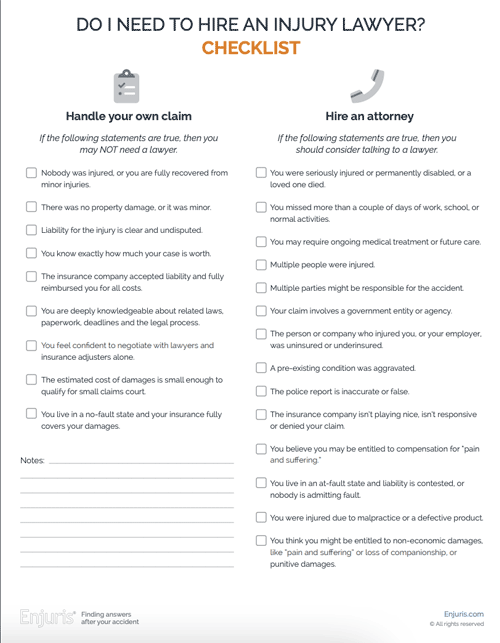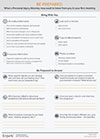
Liability can be tricky to determine, even before you set foot in a courtroom.
Accidents happen. Sometimes the injured person plays a role in their own injuries, though. See how this and other rules can play into how an Illinois court handles personal injury lawsuits.
A personal injury lawsuit is based on the theory of negligence. Negligence is the failure to exercise the care that a reasonably prudent person would exercise in similar circumstances. This is a universal standard. Each state has certain rules for handling personal injury lawsuits, but the standard for negligence is the same in any state.
To establish negligence in an Illinois personal injury lawsuit, the plaintiff must prove four elements:
- Duty of care. The defendant owed a duty of care to the plaintiff. This is sometimes straightforward, for example, a school has a duty of care to its students, a physician has a duty of care to their patients, etc. But you can have a duty of care to someone you don’t know at all. For instance, a driver has a duty of care to all other road users. A shopper in a store has a duty to other people in the store—they shouldn’t be running or reckless or otherwise not paying attention to others’ safety.
- Breach. The defendant breaches their duty of care when they fail to act reasonably to avoid causing harm to the plaintiff. This could be either by action or inaction.
- Causation. The law requires that the defendant’s breach was the direct cause of the plaintiff’s injury. Consider this scenario: Driver A was following too closely behind Driver B. When Driver B came to a quick stop, Driver A gently rear-ended him. Driver B was uninjured but so angry about the light thump that he immediately got out of his car in a rage. When he exited the car, he did not realize there was a pothole next to the door; he stepped in the pothole, lost his balance and fell. He broke his ankle because of his fall from the pothole. Although Driver A caused a collision, he did not cause the ankle injury. Driver B would not be able to claim damages from Driver A for that injury because it was not directly caused by Driver A’s driving.
- Damages. The purpose of personal injury law is to make the plaintiff financially whole. That means the defendant must compensate the plaintiff to restore them to the financial condition they would be in if the accident had never happened. Generally, a plaintiff may claim damages to cover expenses for medical treatment, lost wages, property loss, pain and suffering, emotional distress, and other costs related to the injury.
Illinois modified comparative fault rule
Illinois follows a modified comparative fault rule, also known as the “51% Rule.”
If the plaintiff is less than 51% at fault for their own injury, they may recover damages reduced by their percentage of fault. If they are 51% or more at fault, then they cannot recover any damages.
Here’s how it works in a hypothetical situation:
Plaintiff Patty needs a few groceries, but she’s in a hurry and doesn’t really have time to stop at the store. She’s coming from work and has to get home to feed her kids dinner and get to a school function. Life of a working mom, right? So, she dashes into the supermarket, still dressed from work, so she’s running in her three-inch heels.
As she is running into the store, a shopper drops a bottle of milk and it spills in the dairy aisle. The manager sees the spill on their cameras and immediately dispatches an employee to clean it up. The employee heads over to the aisle, mops the milk, but forgot to bring the “wet floor” sign along. So he leans the mop against the door of the refrigerator to alert customers of slippery conditions and walks away to the back to get the sign.
In the meantime, Patty races around the corner. She’s fielding a call on her phone, not looking at what’s around her, and she is both running and slightly unsteady on her heels because of her speed. She doesn’t see the industrial-sized mop blocking the area and her foot slides on the wet floor. She falls and is injured.
Plaintiff Patty files a lawsuit against the supermarket, alleging that the employee was negligent for leaving a wet floor with no caution signs, even though the majority of the spill was cleaned.
The court ruled that although the employee should have done more to alert customers of the danger of the slick floor, Patty was also at fault. If she had been walking at a normal speed and not running in the store, she likely would not have slipped on the amount of wetness that was present on the floor. In addition, the footwear she wore was not intended for running and would make doing so unreasonably dangerous, particularly on a linoleum supermarket surface.
Patty was awarded $100,000 in damages. She was found to be 30% at fault, so her damage award was reduced by that amount and she received $70,000 for her injuries.
Illinois joint and several liability rules
Each state has laws it follows when there is more than one defendant in a lawsuit.
How does the court determine how much each defendant pays in damages?
Joint liability: If two or more defendants are each liable for the plaintiff’s injury, then each defendant can be held responsible for the full amount of the plaintiff’s damages. The plaintiff may recover the full amount damages from any of the defendants, regardless of the defendant’s share of fault or liability.
Several liability: The defendant is only responsible for their own proportionate share of the damages if their amount of fault is less than 25%. If the defendant is responsible for 25% of the fault or more, they are then jointly liable for the plaintiff’s damages.
By following these rules, a plaintiff may recover full compensation even if one or more defendants cannot pay their share. However, a defendant may seek contribution from other defendants to recover any amount paid that exceeds their individual share of liability.
Do certain circumstances reduce a person’s liability under Illinois comparative fault rules?
Under Illinois law, certain individuals may have extenuating circumstances that can influence how liability is assessed in negligence cases. These circumstances can include:
- Children
Children are generally held to a different standard of care than adults. The standard is based on what is reasonable to expect from a child of similar age, intelligence, and experience. Younger children (under seven) are typically presumed incapable of negligence. For older children, courts consider their maturity and capacity to understand the consequences of their actions. - Mental incapacity
Individuals with mental incapacity are also held to a different standard. The court will evaluate what is reasonable to expect from a person with similar mental capacity under similar circumstances. In some cases, a mentally incapacitated person may not be held liable if they cannot understand or control their actions due to their condition.
Illinois assumption of risk doctrine
The doctrine of "assumption of risk" can play a significant role in Illinois negligence cases.
| Express assumption of risk | Implied assumption of risk |
|---|---|
| A person explicitly agrees, usually in writing, to accept the risks of a particular activity. For example, if you sign a waiver before participating in a dangerous activity like skydiving, you acknowledge that you understand the dangers. If express assumption of risk is proven, it can bar the plaintiff from recovering damages. | A person implicitly accepts the risks associated with an activity through actions or conduct. For example, if someone participates in a contact sport, they are considered to have accepted the inherent risks of injury. Implied assumption of risk can reduce the defendant's liability but does not necessarily bar recovery altogether. |
In Illinois, implied assumption of risk is considered as part of the comparative fault analysis. The jury will consider whether the plaintiff knowingly and voluntarily accepted the risks, and to what extent this acceptance contributed to the injury. The plaintiff's damages may be reduced by their percentage of fault due to the assumption of risk.

Can you handle your own claim, or should you hire an attorney? Use this worksheet to determine when you should consider hiring a personal injury or workers' comp lawyer.
Download in PDF format

A worksheet to prepare for your first meeting with a personal injury attorney – what to bring, what they'll ask
Download in PDF format
See our guide Choosing a personal injury attorney.
